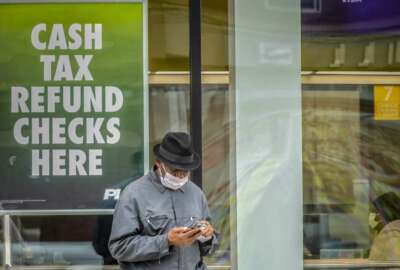
Hubbard Radio Washington DC, LLC. All rights reserved. This website is not intended for users located within the European Economic Area.
Hubbard Radio Washington DC, LLC. All rights reserved. This website is not intended for users located within the European Economic Area.
Digital services and modernization are pillars of the Biden administration's management agenda. These efforts don't just matter to federal agencies, though, bus...
Best listening experience is on Chrome, Firefox or Safari. Subscribe to Federal Drive’s daily audio interviews on Apple Podcasts or PodcastOne.
Digital services and modernization are pillars of the Biden administration’s management agenda. These efforts don’t just matter to federal agencies, though, business is thoroughly behind efforts to streamline government services. In fact, the Chamber of Commerce has put some numbers on what paperwork costs the economy each year, and how many hours it eats up. Here with the details, Chamber Vice President Jordan Crenshaw talked to the Federal Drive with Tom Temin.
Interview transcript:
Tom Temin: And I think anyone that’s ever applied for anything to do with the government realizes there’s a lot of paperwork, You had to figure on how many forms the government promulgates, what is that number, and it’s even higher than I thought.
Jordan Crenshaw: So it’s actually 9858 different forms across just the federal government alone.
Tom Temin: And you have come up with some research on how much time Americans spend per year in aggregate, filling out those forms, and the cost of that, and just give us those top line numbers.
Jordan Crenshaw: You know, in terms of what we’ve seen from the federal government, COVID has really exposed the need for government to digitize and modernize. And one of the reasons why we did this report is we wanted to look at those costs that are out there associated with non-digital processes out there. And the government just from using non-digital processes actually adds 10.5 billion hours that are actually used up and that’s a cost to Americans of $117 billion. And just one example alone, you look at the IRS, they had a backlog of about eight months because of a lack of digitization. And that actually ended up being a result in $3 billion in interest just because of the lag time. And so it’s just critical that the government began to think of ways that it can start digitizing its processes, so it can better serve citizens, but also even make us more resilient against some of the next challenges we’re gonna face, too.
Tom Temin: Sure. And that figure of 10 billion man hours a year, if I did my math right, does that work out to 90 hours per person?
Jordan Crenshaw: You know what? I’m a lawyer, so I wasn’t a mathematician, but I’m going to trust you on that one right there.
Tom Temin: Yeah, it’s a lot, even if it’s only nine hours. But I think it seems like closer to 90, I guess, if you do taxes and so forth. So you like what you see, then with respect to that issue of the President’s management agenda, which is concerned with customer experience, modernization, there’s a lot of different facets of it. But it all has that kind of rubric of getting government much more online and digitizing those efforts that are now paper.
Jordan Crenshaw: We’re incredibly thrilled to see that the administration wants to tackle this issue. You know, we were happy that in the last year, an extra billion was added to the technology modernization fund. We also are really appreciative of the fact that Congress is now beginning to take even more of a look at this with the launch of the new IT Modernization Caucus, and that’s being led by Congressman Gerry Connolly in Northern Virginia and Darrell Issa from the San Diego area. They’ve come together to really start to try to solve issues around what are the impediments for government to modernize. But at the same time, let’s take a look at some of the areas that the government could make strategic investments that could pay off in the long run.
Tom Temin: Well, I guess if we can get Darrell Issa and Gerry Connolly to work together on something, it must really matter across the board.
Jordan Crenshaw: I think that’s indicative of the fact that this is a bipartisan issue that if we can get government working better, and we can also have the private sector in places stand in the gap where it has expertise to help out the federal government, we think that that’s a really great solution if we can get the right funding in place, the right private partners in place and also look at ways we can get rid of those impediments to modernization. That’s going to be a real key to ensuring that our governments can be resilient against the next challenges. I mean, you have to take a look at the fact that when we started with the COVID lockdowns, you know, we were dealing with even state systems that were crashing, you know, we had 8300 people trying to apply a day on the Connecticut system. And that was crashing their system, New Jersey was calling for COBOL technicians because they didn’t have them in place. And so it was funny. I was actually at the Houston Space Center a couple of weeks ago and started thinking to myself, “Wow, this is the same tech we’re using now in some government agencies, at least that era.” And so I think one of the things that we want to make sure we do is we begin to modernize systems across the board, not just digitizing, but investing and key digital infrastructure as well, that will be helpful. They’ll secure government but also make it better effective for citizens as well.
Tom Temin: We’re speaking with Jordan Crenshaw, he’s vice president for the Technology Engagement Center at the U.S. Chamber of Commerce. And you mentioned earlier that industry can help here, industry can always help as a contractor that the government pays and that’s how they typically go about using industry. But you are the Chamber of Commerce and lots of industries have become models for digital services. I don’t mean just ecommerce, but traditional industries like airlines that are really good at deploying these types of digital services. Do you see a way that they can help government bridge the gap outside of the formal contracting processes because nobody’s going to hire a an airline as a subcontractor for digital services. And yet, there’s so much expertise there.
Jordan Crenshaw: Well, I think the private sector can lead in solutions that can be deployed at scale on the federal level and on the state level as well, too. And I think that that’s an area where the private sector can innovate and those solutions can trickle into government. I also, you know, I think from a contracting perspective, though, I think we can also look at areas where can we look at software that can be more nimble across different agencies, as opposed to having to have agency by agency structures put in place, which actually might slow down modernization in the future and makes agencies more nimble. So I think those are some areas where I think the private sector can be a real help. But it’s not just areas of forms. It’s a customer resource management, where the government can better keep track of its customers from a DMV level all the way up to a federal agency level. And so I think there are a lot of ways the private sector can stand in the gap and bridge the gap. But there are also a lot of other impediments out there, we can look at how do we retain talent in federal agencies to make sure that CIOs continue to see projects through. I think there are a lot of areas that we as the private sector wants to help, but also areas where the new IT Modernization Caucus can examine for future legislation going forward.
Tom Temin: And another issue that came to light in the COVID response besides the brittleness and sometimes the datedness in the paper intensivity, if you will, of the systems, and that is how ripe the current processes are for fraud. And we still don’t know really the extent of fraud that happened under all of these pandemic relief programs, but it’s hundreds of billions. And Lord knows how much it seems like in a digital environment, the cross checks, the data matching, all of those processes that can prevent fraud would be automated, instantaneous. Instead of having people shift through paper, which they can’t do, which we found out they could not do. I wonder if that’s part of the thinking also?
Jordan Crenshaw: Well, paper isn’t actually, you know, inherently the problem. I think the real problem here is that the government is not investing in digitization the way it should be. And I think one of the issues there is there are a lot of different solutions out there that can be used with digitizing government data. For example, if you look at the private sector, the private sector is deploying data tools, including things like artificial intelligence to identify fraudulent activity. And you know, I spoke with one CIO from the city the other day, who said, when they were able to start focusing more on digitization, they could really get into the data analysis, and ways that they could cut down on inefficiencies. So there are other tools out there that I think the government could take a look at as well to everything from artificial intelligence to blockchain to really new and emerging tech. And it’s not just connectivity, it’s not just purely digitization, but there are other tools that could be used to really harness those efficiencies.
Tom Temin: And, of course, a form and each one of those 9000, roughly 10,000 forms represents a process. And probably there’s an opportunity to rethink the processes and we used to call it “business process reengineering.” I’m hearing that phrase come back into the lexicon now, as people talk about digital in the government. Make sense?
Jordan Crenshaw: I mean, I think there’s another way to take a look at all these different areas. You know, I think in terms of identity management, for example, there could be new identity management technologies that could be used in place of the current processes. I think there’s a lot of ways we could reimagine how government operates. But I think we need to really start developing a strategy on the congressional level as well as at the administrative level to really get this going. But no, I agree. I think there are ways that we could try to change the processes in general, and even how agencies procure and how agencies retain talent. I think this is going to be an all of the above approach when it comes to ensuring that we get government into the 21st century.
Tom Temin: And briefly, you’ve got an event coming up on this very topic.
Jordan Crenshaw: Exactly. We’ll actually host the U.S. Chamber: A Digital Transformation Summit on February the second. It will bring together CIOs, will bring together the business community and policymakers to really talk through these issues. So any of your listeners, we’d love to have them out.
Tom Temin: All right, Jordan Crenshaw, is vice president for the Technology Engagement Center at the US Chamber of Commerce.
Copyright © 2024 Federal News Network. All rights reserved. This website is not intended for users located within the European Economic Area.
Tom Temin is host of the Federal Drive and has been providing insight on federal technology and management issues for more than 30 years.
Follow @tteminWFED

